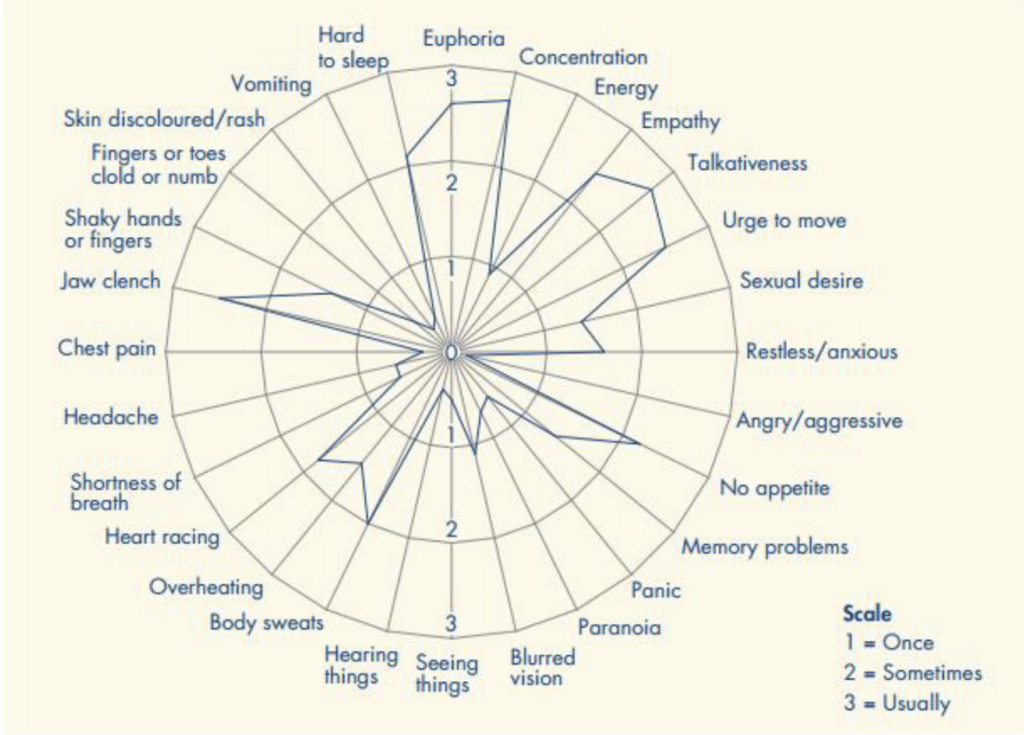For a long time there have been no articles on the site about a specific substance and Harm Reduction for it. Let’s fix it! Today I will try to tell you some details, facts and, of course, give recommendations about the most popular of so-called new psychoactive substances (NPS). Let’s talk about Harm Reduction for Mephedrone.
What is Mephedrone?

Mephedrone is a synthetic stimulant drug that belongs to the cathinone class. It is also recognized as 4-methyl methcathinone (4-MMC), ‘meow meow,’ ‘M-CAT,’ or ‘drone’. It was first synthesized in 1929, derived from the active ingredient (cathinone) found in the leaves of the khat plant (catha edulis) traditionally chewed in East Africa and the Arabian Peninsula.
The drug made its appearance in drug markets, including Israel, Australia, and the United Kingdom, in 2007. It was first identified by police in France in 2007 when they examined what they believed to be an MDMA tablet. By 2008, due to its adverse effects, mephedrone became illegal in Israel. However, China began exporting the drug, and its presence rapidly increased in Britain from 2009 to 2010. It became a popular supplement or replacement for MDMA among dance clubbers, and it keeps its popularity among NPS and other substances until now for its stimulant and euphoric effects.
How Mephedrone works?

When mephedrone enters the body, it acts as a releasing agent and reuptake inhibitor of certain neurotransmitters, particularly dopamine, norepinephrine, and serotonin. Mephedrone increases their levels in the synaptic cleft, leading to increased neurotransmission and prolonged effects.
Dopamine is involved in the brain’s reward pathway, regulating motivation, pleasure, and reinforcement. By increasing dopamine levels, mephedrone produces a sense of euphoria and reward, contributing to its addictive potential.
Norepinephrine is a neurotransmitter that plays a role in regulating arousal, attention, and blood pressure. Mephedrone’s actions on norepinephrine contribute to increased alertness, energy, and heightened physiological responses such as elevated heart rate and blood pressure.
Serotonin is involved in mood regulation, appetite, and sleep. Mephedrone’s effects on serotonin can lead to mood elevation and increased sociability, but also carry the risk of adverse effects such as anxiety, agitation, and potentially serotonin syndrome in cases of excessive serotonin release.
Mephedrone can be taken orally, snorted, or injected. It is rapidly absorbed into the bloodstream and quickly crosses the blood-brain barrier, exerting its effects on the central nervous system. The effects of mephedrone typically last for a few hours, and users may experience increased energy, heightened sociability, enhanced mood, and increased sexual arousal.
It’s important to note that mephedrone’s exact pharmacological profile is still being investigated, and the full extent of its effects and potential long-term consequences are not yet fully understood.
Dangers of Mephedrone

Mephedrone exerts its influence on various bodily systems, including the cardiovascular, gastrointestinal, musculoskeletal, and central nervous systems. Among the most common side effects of Mephedrone are the following:
- Bruxism (teeth grinding and jaw clenching)
- Paranoia
- Nasal soreness and nosebleeds
- Hot flushes
- Memory loss
- Insomnia
- Depression
- Vomiting
- Chest pains
- Skin rashes
Intravenous administration of the drug has been associated with side effects such as paranoia, aggression, and spasms, according to Van Hout and Bingham in 2012.
The after-effects of mephedrone resemble those experienced during the comedowns of MDMA and amphetamines, including dizziness, low mood, and fatigue.
Adverse health effects of Mephedrone can also include tachycardia (rapid heartbeat), hypotension (low blood pressure), and fever-like symptoms. In one instance, a severe yet reversible case of dilated cardiomyopathy (a type of heart muscle disease) occurred following mephedrone use. It’s important to note that other potential causes of cardiomyopathy were thoroughly examined and ruled out. Methemoglobinemia, characterized by increased levels of methemoglobin in the blood, has also been associated with mephedrone use.
Several case studies have reported additional associations between mephedrone use and specific health conditions. These include pneumomediastinum (air in the mediastinum) and subcutaneous emphysema. Acute kidney injury has also been linked to mephedrone use. Other isolated adverse health conditions include urinary retention requiring catheterization and posterior reversible encephalopathy syndrome (PRES) resulting from mephedrone insufflation. PRES is characterized by symptoms such as headaches, visual loss, confusion, and seizures.
While it may be argued that mephedrone was not the sole cause of these conditions in many cases, the authors assert that it played a significant role in triggering the onset of these adverse health outcomes.
Mephedrone Fatal Cases
The first documented case of death directly associated with mephedrone use occurred in Sweden in 2008. A young 18-year-old female experienced cardiorespiratory arrest, and subsequent analysis of blood and urine samples confirmed the presence of mephedrone as the only drug involved (as reported by Gustavsson and Escher in 2009). Another case involved the death of a young male who suffered brain stem failure and lung injury, with mephedrone being the sole identifiable substance found during post-mortem examinations (as stated by Adamowicz et al. in 2012). Several other fatal incidents related to intoxication have been reported, although mephedrone was not the sole drug involved in many cases, and existing health issues may have contributed to the fatalities. In 2015, a study examined deaths among individuals aged 16 to 24 years that were linked to mephedrone over a four-year period.
Harm Reduction Practices for Mephedrone

Prevention is the best approach to dealing with mephedrone-related health problems. It is important to understand the risks associated with drug use and make informed decisions. Since mephedrone is atypical, but a representative of the class of euphoretic stimulants, the same principles of Harm Reduction for Stimulants will work for it
Harm reduction strategies aim to minimize the negative consequences associated with drug use. When it comes to mephedrone, a synthetic stimulant substance, implementing Harm Reduction practices can help reduce potential risks and promote safer use. Here are some recommendations specifically for Mephedrone:
Educate Yourself
Obtain accurate and reliable information about mephedrone, including its effects, risks, and potential interactions with other substances. Understanding the substance can empower you to make informed decisions and take necessary precautions.
There are many wonderful websites, blogs, forums and communities on the web that broadcast the necessary information. Mindheal is one of such projects, and in our bot you can find a list of useful links.
Test the Substance
Using drug testing kits for Harm Reduction can help verify the presence and purity of mephedrone. This can help you avoid potential contaminants or other substances that may increase the risk of harm. Testing kits can be obtained from harm reduction organizations or purchased online. For example:
Use in a Safe Environment
It is crucial to prioritize safety when using drugs, including mephedrone. Here are some additional tips to consider:
Choose a familiar and safe environment: Use mephedrone in a place where you feel comfortable and secure. Being in a familiar environment can help reduce anxiety and potential risks.
Avoid operating vehicles: It is strongly advised not to drive a car or ride a bike while under the influence of mephedrone. The drug can impair judgment, coordination, and reaction times, making it unsafe to operate any vehicle.
Stay away from hazardous locations: Refrain from being near hazardous areas such as cliffs, rocks, pools, ponds, or large bodies of water. Impaired judgment and coordination can increase the risk of accidents or drowning.
Share your plans with friends: Inform trusted friends about your drug use plans, including your intention to use mephedrone. This way, they can keep an eye on you, provide support if needed, and ensure everyone’s safety. It’s also important that your group has a reliable and safe transportation plan to get home.
Start with a Small Dose
| Oral | Insufflated | Intravenous | |
| ⚪ Light | 1.5-2 mg/kg | 0.4-0.9 mg/kg | 0.15 mg/kg |
| 🟡 Medium | 2 – 2.5 mg/kg | 0.9-2 mg/kg | 0.15-0.25 mg/kg |
| 🔴 Severe | 2.5 mg/kg or more | 2 mg/kg or more | 0.25 mg/kg or more |
If you choose to use mephedrone, begin with a low dose to assess its effects on your body. Different individuals can have varied responses to substances, so starting small can help minimize the risk of adverse reactions. I also want to note that the dosage of mephedrone is very different depending on the route of administration of the substance. For intravenous use, the dosage will always be minimal, the nasal route will be slightly larger, and the oral route is the largest. This is a very important point because confusing or not complying with this principle can be dangerous for health and life.
It is essential to exercise caution and accuracy when measuring doses of mephedrone or any other substance. While the information you provided suggests various methods for measuring doses, it is important to note that precise dosage is crucial for harm reduction and minimizing potential risks. Here are some points to consider:
Use electronic scales: Kitchen milligram electronic scales are the most accurate option for measuring mephedrone doses. They provide precise measurements, especially considering the high purity of the substance. Using scales ensures greater control and reduces the risk of unintentional overdose.
Consider alternative measuring tools: If electronic scales are not available, alternative measuring tools can be used. These include using a hole in a cigarette filter, specialized measuring spoons, or the gelatin capsules. However, it’s important to recognize that these methods may not provide the same level of accuracy as electronic scales.
Avoid relying solely on visual estimation: The eye method of measuring doses is highly unreliable and imprecise. Visual estimation can lead to significant errors, with difficulty distinguishing between different dosage levels. Relying solely on visual estimation is discouraged due to the risk of inaccurate dosing.
It is crucial to prioritize safety and harm reduction by using accurate measuring tools, such as electronic scales, whenever possible.
Exclude injecting and repetitive redosing
Intravenous administration not only increases the chances of contracting an infectious disease and catching an overdose but also increases the rate of tolerance development, reveals the addictive potential of the substance, and closes the neuronal feedback arcs so tightly that it will be very difficult for the brain and consciousness to escape from the current situation.
Frequent and uncontrolled redosings also contribute to a faster formation of tolerance, dependence, and deterioration of the body and consciousness.
Harm reduction for mephedrone is impossible with these two aspects of use. It is really very important to exclude them.
Avoid Polydrug Use
Combining mephedrone with other substances, such as alcohol or other drugs, can increase the risk of adverse effects, including cardiovascular issues and overdose. It’s best to avoid polydrug use and be aware of potential drug interactions.
Alcohol significantly enhances adverse reactions and increases the neurotoxicity of CNS stimulants. Other substances, regardless of the class, will use additional resources of the body, create stress points and unpredictable pharmacological triggers that will increase the risks of adverse reactions, overdose effects, psychosis, seizures, coma, and so on.
Stay Hydrated

Hydration is indeed important when using mephedrone or any other substance, as dehydration can be a potential risk. However, it is essential to provide accurate information and clarify a few points regarding hydration and electrolyte balance. Here are some considerations:
Hydration: Drinking water in small portions regularly is a good practice to prevent dehydration. However, the suggested intake of 250 ml per hour may vary depending on factors such as individual metabolism, activity level, and environmental conditions. It’s important to listen to your body’s signals of thirst and adjust your water intake accordingly.
Overhydration: While it’s crucial to stay hydrated, overhydration can also be dangerous. Drinking excessive amounts of water within a short period can lead to a condition called hyponatremia, which is a low concentration of sodium in the blood. This can be harmful and even life-threatening. It is advisable to maintain a balanced approach to hydration and avoid excessive fluid intake.
Electrolyte balance: Electrolytes play a vital role in maintaining proper hydration and body functions. While water is essential for hydration, it is also important to replenish electrolytes lost through sweating and other bodily functions. However, it’s important to note that simply saturating water with electrolytes may not be sufficient to meet your body’s electrolyte needs. Consuming a balanced diet that includes foods rich in electrolytes and considering electrolyte drinks or supplements may be beneficial.
Eliminate overheating
It is crucial to control your body temperature and prevent overheating when using mephedrone or engaging in any strenuous activity.
Environment: Be mindful of the environment you’re in. Avoid prolonged exposure to excessive heat, such as staying under the sun for extended periods or being in poorly ventilated and stuffy rooms. Seek cooler areas or take breaks in shaded or air-conditioned spaces.
Clothing: Dress appropriately for the temperature and activity level. Wear lightweight, breathable clothing that allows heat to dissipate and sweat to evaporate. Avoid overdressing or wearing tight-fitting clothes that may impede heat regulation.
Rest and breaks: Take regular breaks from physical activity, especially in hot environments. Resting allows your body to cool down and recover from exertion.
Awareness of symptoms: Be aware of the signs of overheating, such as dizziness, rapid heartbeat, nausea, headache, and feeling excessively hot. If you or someone around you experiences these symptoms, take immediate steps to cool down, seek shade or a cooler environment, and consider seeking medical assistance if needed.
Heatstroke prevention: Heatstroke is a severe and potentially life-threatening condition caused by overheating. If someone exhibits symptoms like confusion, loss of consciousness, seizures, or hot, dry skin (lack of sweating), call emergency services immediately. While waiting for help, move the person to a cooler area, remove excess clothing, and try to lower body temperature using cooling measures such as applying cool water or ice packs.
Take Breaks and Pace Yourself
Avoid using mephedrone repeatedly or for prolonged periods. Taking regular breaks and allowing your body to rest and recover can help minimize the risk of overexertion, tolerance buildup, and potential negative consequences. Here are some general guidelines for post-use recovery:
Sleep: Aim to get an adequate amount of sleep to allow your body to rest and restore itself. Stick to a regular sleep schedule and create a sleep-friendly environment to promote quality sleep.
Nutrition: Focus on consuming a balanced diet rich in nutrients to support your overall health. Include fruits, vegetables, whole grains, lean proteins, and healthy fats in your meals. Stay hydrated by drinking plenty of water and avoid excessive consumption of sugary or caffeinated beverages.
Hydration: As mentioned earlier, maintaining proper hydration is crucial. Drink water regularly, but be mindful of the recommended limits to avoid overhydration.
Physical activity: Engage in moderate exercise or physical activities that you enjoy. Exercise can help improve mood, reduce stress, and support overall well-being. However, avoid intense workouts or physical exertion during the recovery phase.
Relaxation techniques: Explore relaxation techniques such as meditation, deep breathing exercises, or mindfulness practices to promote relaxation and reduce stress.
Seek Support and Help
Seek support from friends, family, or support groups who can provide understanding and encouragement during your recovery process. Connecting with others can help reduce feelings of isolation and promote emotional well-being.
If you’re struggling with mephedrone use or any substance misuse, reach out to healthcare professionals, addiction specialists, or harm reduction organizations. They can provide guidance, support, and resources to help you make informed decisions and address any problematic drug use.
Summary

Harm Reduction strategies aim to minimize the negative consequences associated with drug use, including substances like mephedrone. Providing accurate and evidence-based information about the risks and potential harms of mephedrone use is essential.
Encouraging safer administration methods, such as avoiding injecting mephedrone and instead choosing oral or nasal routes, can reduce the risk of infections and other complications. Using clean needles and other paraphernalia, if the injection is unavoidable, can also help prevent the transmission of bloodborne diseases.
Encouraging individuals to start with low doses of mephedrone and avoid repeated redosing can help minimize the risk of overdose and excessive stimulation. It is crucial to be aware of the purity and potency of the substance, as adulterants can increase the risk of adverse effects.
Creating non-judgmental and supportive environments for individuals using mephedrone can facilitate open conversations about drug use, encourage seeking help, and reduce the stigma associated with substance use disorders. Access to harm reduction services, such as needle exchange programs and drug checking services, can also play a crucial role in reducing the risks associated with mephedrone use.
Ensuring that individuals have access to healthcare services and counseling can help address any physical or mental health issues associated with mephedrone use. Regular check-ups, screenings for bloodborne infections, and mental health assessments can contribute to early intervention and appropriate care.
Remember, harm reduction strategies aim to minimize harm, but they do not eliminate risks entirely. The safest approach is to abstain from drug use altogether. If you decide to use mephedrone, it’s crucial to prioritize your well-being, make informed choices, and seek help when needed.
✔️
This marks the finish of today’s session. It is my hope that this piece was enlightening.
If you want to advance the growth of this blog, I suggest the following actions:
- Subscribe to our social networks.
- Circulate a link to this article among your associates.
- Give recognition to this blog on relevant platforms or discussion groups.
Should you identify any necessary additions or corrections in this article, feel free to initiate a dialogue with me via Contact Form. I am always open to communication.
I appreciate your valuable time and consideration 🔮




